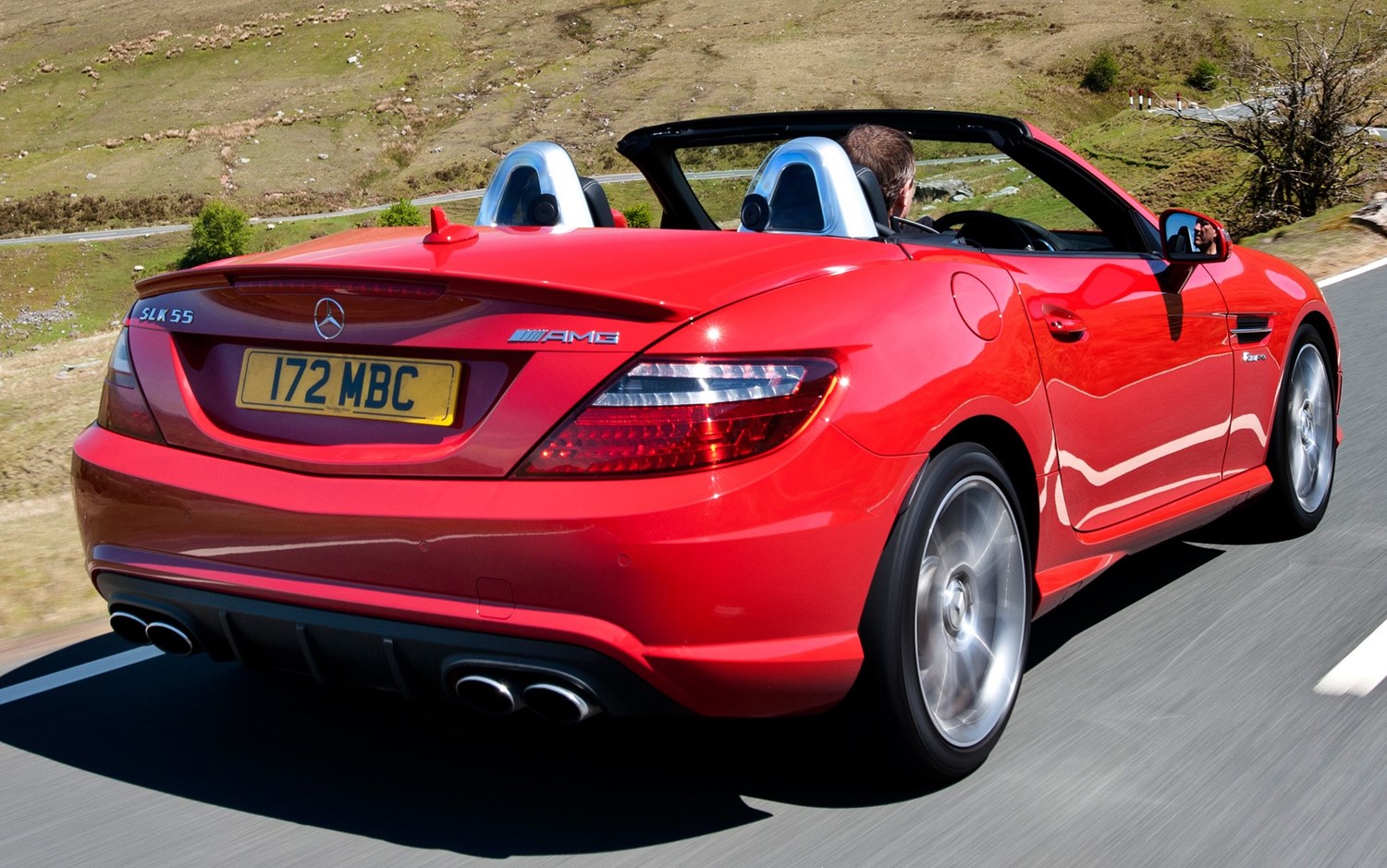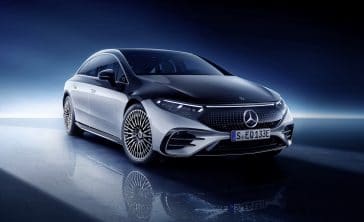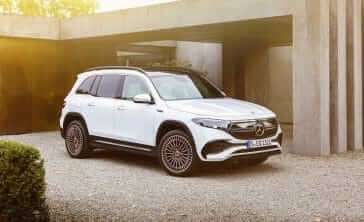Model review
The SLK – named for its design parameters of 'sportlich' (sporty), 'leicht' (light) and 'kurz' (short) – was introduced in 1996 as part of the regeneration of the small roadster category, and in fact the Mercedes-Benz brand itself.
Cars like the Mazda MX-5 revived the British lust for convertibles and created the conditions for the SLK's creation, which subsequently also saw small convertibles from Porsche, Audi and BMW. The first SLK was revealed as a concept in 1994, before going to full production in 1996. Unexpectedly it retained its concept car party-piece, the 'Vario-Roof'.
While commonplace today, the SLK's Vario-Roof was a showstopper: an automatic folding metal hard-top that retracted into the boot space to give both fixed roof security and convertible freedom. The roof could go from one position to the other in 25 seconds.
It arrived a time when Mercedes was merely making saloon cars – the C-Class, E-Class and S-Class – alongside the Vito van and classic G-Class 4x4. Along with the much larger SL-Class, the SLK provided a sporting edge to the brand that has been evident ever since. The original car used a brace of four-cylinder petrol engines, but after a facelift in 2000 it gained a V6 and an AMG-tuned, supercharged version to create the SLK32 AMG.
The second generation car arrived in 2004 and is immediately obvious by the F1-inspired front-end. This features a tapering nose, ending in the Mercedes tri-star, with a pair of winglets either side in the grille, similar to the £300,000, 200mph McLaren-Mercedes SLR performance GT car produced the same year.
The new car retained the folding metal roof, but most of the engines were now six-cylinder units, with only the entry level car retaining its four-pot. AMG upgraded the SLK to take a 5.5-litre V8 and this SLK55 became the first in the 'Black Series' of even higher-powered AMG cars.
The SLK was renewed for a third generation in 2011, bringing a new, stubbier front end that again aped a Mercedes performance GT, this time the SLS AMG. Mercedes stuck with the folding metal roof format again, but this time added diesel power to attract buyers looking for low emissions and low tax rates for their convertible sports car.
When Mercedes revised its named system the SLK was one of the anomalies, so when the car was face-lifted in March 2016, 20 years after the first car, the SLK name was retired in favour of the SLC.

Latest model
The third generation – or 'R172' to Mercedes aficionados – was introduced in 2011. Like its predecessors, this new SLK was based on the Mercedes C-Class, but offered the two-door, two-seat roadster experience.
Importantly the car retained the folding metal 'Vario-Roof' that had made the first SLK such a significant car, although for the first time it was offered with a panoramic sunroof or the incredibly unusual 'Magic Sky Control', which essentially allowed the driver to vary the transparency of the sunroof.
Engine choices were reasonably varied, with the SLK200 and SLK300 offering four-cylinder petrol engines and the SLK250d's diesel.
Performance was brisk, but the SLK55 AMG offered considerably more power from its V8. While the second generation SLK55 may have served as the basis for the first ever 'Black Series' AMG vehicle, this disappeared with the third generation car, leaving the regular SLK55 as the top model.
You had a pretty simple choice when it came to specifications, with a standard trim level and the AMG Sport above it.
Equipment wasn't comprehensive – satellite navigation was an option except on the SLK55 AMG and entry level cars had cloth seats – but not atypical of the era. By the end of the model's life in 2016, all cars did at least have air conditioning, DAB radio and Bluetooth connectivity for your mobile phone.
Value for money
For a two seat convertible, a starting price of over £30,000 seems a little steep. Even though the car accomplished a 0-60mph sprint under seven seconds at this entry point, it's not as if the SLK backed the price up with high performance or even particularly impressive equipment levels. However, the SLK was a larger and more spacious car than it seemed, and the metal roof did not come cheap.
When the model was phased out in 2016, all cars had as standard equipment at least air conditioning, electric windows, DAB tuner, rake and reach steering wheel, Bluetooth connectivity, pre-safe collision mitigation and heated and electrically adjustable door mirrors.
Some of the options list was impressively expensive – the 'Magic Sky Control' roof added another £2,000 to the list price – so buyers would need to take care not to deviate too far from the standard specifications. AMG Sport models were pretty much complete for the day, even if navigation was another £500 minimum.
The SLK's running costs were rather favourable though. High insurance group aside – even though the car didn't use a fragile and vulnerable fabric roof, the SLK started in group 41 – all models achieved solid fuel economy figures, even the 33mpg SLK55.
On paper the diesel SLK250d could return more than 70mpg which, although unlikely in the real world, is very impressive. However, we don't envy the bill for an SLK driver who finds their clever roof has stopped working...
Depreciation is a mixed bag, but the diesel car rates well simply for its low running costs, while the AMG will retain value on the basis of its special interest. Expect around 55% depreciation over three years for a car with the right choices made when it was originally ordered – an SLK250d in AMG Sport specification with leather and navigation added.
Looks and image
The SLK has always been a smart little car, although the first generation was a little bit goofy from the front and a bit of a wedge-shape overall. It's evolved over time into quite a pretty thing with a rather purposeful stance, in part helped by the front end following design cues of the brand's best-performing vehicles – the SLR and SLS.
Although cliched, there is an essence of hairdresser about the SLK though. Despite some decent performance across the range – leading into some properly savage pace from AMG cars – the slightly aloof handling and steering makes it more of a cruiser than a sports car and it gives off the image that the owner is more interested in the style of the thing than for the drive.
This isn't intrinsic to the SLK either, as many Mercedes convertibles have had the same image over the years.

Space and practicality
Unless you're a family of two, the SLK doesn't have much of a family appeal. It's two seats and two seats only, but they are at least comfortable, roomy seats. Headroom and legroom are more than enough for two adults, whether the roof is up or down – or with the panoramic sunroof option eating a few millimetres of headroom.
The 335-litre boot space is about equal to a modern hatchback, but it does come with a catch. The folding roof has to go somewhere, and when it's stowed away it eats into that boot space to the tune of 110 litres. What remains is still good for a supermini, but it's something to consider when taking the top off.
After the first generation car was tested in 2002, no SLK has been tested by EuroNCAP. However, the C-Class on which it's based is a five-star car and all SLKs of the most recent type include four airbags, an active bonnet, electronic stability control, attention assist to alert the driver to drowsiness, crash-responsive head restraints and pre-safe collision mitigation.
Engines
At the end of its life there were four engine options for the CLK, with one diesel and two petrol in the ordinary range and a V8 petrol for the SLK55 AMG.
The range started with the SLK200, a 2-litre, 4-cylinder turbocharged petrol engine. This produced 181hp, which enabled 0-60mph to be dusted off in 6.8s (6.7s with the optional automatic) and a 149mph top speed. Combined fuel economy rated at 43.5mpg (150g/km) for the manual and 47.9mpg for the auto (137g/km).
Another version of this engine appears in the SLK300, exclusively fitted with an automatic gearbox. With the power turned up to 241hp, it's more than a second quicker at 5.6s, and combined fuel economy is still a solid 47.1mpg (138g/km). Top speed is limited to 155mph.
The diesel SLK250d is the emissions and economy champion here, rated at 70.6mpg and 114g/km. This 2.2-litre, auto-only engine has 201hp and hits 60mph in 6.4s, with a 152mph top speed.
Above all others is the 5.5-litre V8 petrol in the SLK55 AMG. With 416hp, this blitzes the 60mph run in just 4.4 seconds and on to a limited 155mph top speed – although this can be raised to a 175mph limiter with an AMG performance pack. Fuel economy suffers a little, with 33.6mpg combined, or 195g/km CO2.
Running costs
The SLK's running costs are mixed news. Naturally the diesel achieves very impressive fuel economy figures and the lowest VED of all – just £30 a year – but it's the exception.The two petrol cars rank in the mid-40s, which is arguably solid for the performance offered, and will cost you about £200 a year to tax. The 33mpg of the V8 SLK55 is creditable too, not that anyone buys a V8 on the basis of fuel economy.
The two petrol cars rank in the mid-40s, which is arguably solid for the performance offered, and will cost you about £200 a year to tax. The 33mpg of the V8 SLK55 is creditable too, not that anyone buys a V8 on the basis of fuel economy.
Insurance is the wrinkle here. The basic, entry grade, petrol SLK200 is in insurance group 41, which is incredibly high for a £30,000 car with a solid, secure metal roof. The majority of cars slot into groups 43-45 and the AMG is, despite the performance, only in group 48. Do not be surprised to see rather high insurance quotes.
The newest SLKs are now a year old, and that means that someone else will have felt the hard pinch of year one depreciation. Expect to hold onto about 50% of the car's original value after three years, but a car with the right toys and engine options could do far better.
While the sheet metal is unique, a lot of the bits under an SLK are shared with the Mercedes C-Class. This should help bring repair bills down thanks to availability of parts, but watch out for the bespoke components like that folding metal roof. If that goes wrong you could see a very large bill indeed.

Things to look out for
While the early days of the SLK coincided with the nadir of Mercedes' reliability, the SLK itself seems to have been largely unaffected. This good form has continued to the latest cars, produced at a time when Mercedes itself is enjoying a return to its bulletproof reputation.
Some recalls have affected the SLK though, largely centring on engines it shares with other Mercedes products, so ensure that these have been attended to. On the latest cars, a recall was issued in 2016 for almost a thousand vehicles with the 9G-Tronic automatic as a battery fault could prevent park from being selected and allow the vehicle to roll away.
Check the roof mechanism closely for reliable operation and check for signs of abuse on SLK55 AMG models. One optional extra was a driver training course which came with a speed limiter lift to 175mph, so take extra car with those models.
Rivals
Unsurprisingly, the key rivals for the SLK also come from Germany. Audi's TT gets the style vote, while the Porsche Boxster heads the class for brand prestige, driving thrills and performance – although with the SLK55 AMG it's not likely that it'll get too far away.
Probably the most direct fight is with the BMW Z4 – also recently cancelled – which hits the same marks and, in its last generation, also had a folding hard top roof.
At the lower end of the price range you might consider a Mazda MX-5 RF with just about every box ticked, but it's not likely to quite match the performance figures. At the other end of the scale, the SLK55 AMG is about the same price as the stunning Jaguar F-Type.
Depreciation warning
The SLK reached the end of its life in 2016 and even those latest cars will have suffered the largest slide in value they'll ever experience.
How they continue decline is very sensitive to specification. There will be no shortage of buyers, as the SLK is a decent car with good engines and a solid image, but the first owner will need to have ticked the right boxes. Get everything right and you're looking at a three year retained value of 55% or better.
Buyers may expect the automatic gearbox rather than the manual, and the 250d engine sells itself with 70mpg on paper. £2,000 spent on a sunroof you can change from dark to clear would be a rarely-used gimmick, but £2,000 spent on the COMAND navigation and infotainment system would see a decent return.





